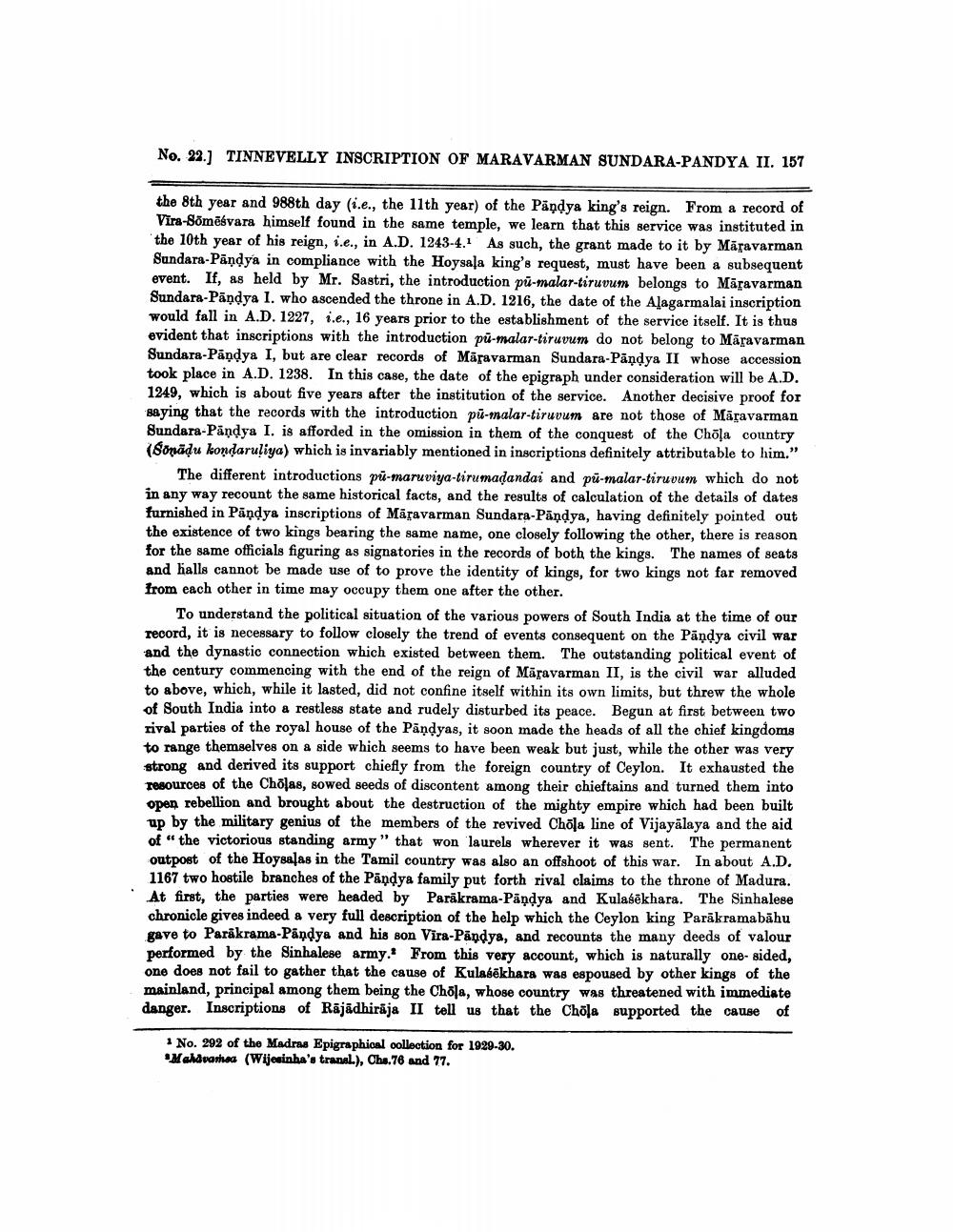________________
No. 22.] TINNEVELLY INSCRIPTION OF MARAVARMAN SUNDARA-PANDYA II. 157
the 8th year and 988th day (i.e., the 11th year) of the Pandya king's reign. From a record of Vira-Somesvara himself found in the same temple, we learn that this service was instituted in the 10th year of his reign, i.e., in A.D. 1243-4. As such, the grant made to it by Maravarman Sundara-Pandya in compliance with the Hoysala king's request, must have been a subsequent event. If, as held by Mr. Sastri, the introduction pu-malar-tiruvum belongs to Maravarman Sundara-Pandya I. who ascended the throne in A.D. 1216, the date of the Alagarmalai inscription would fall in A.D. 1227, i.e., 16 years prior to the establishment of the service itself. It is thus evident that inscriptions with the introduction pu-malar-tiruvum do not belong to Maravarman Sundara-Pandya I, but are clear records of Maravarman Sundara-Pandya II whose accession took place in A.D. 1238. In this case, the date of the epigraph under consideration will be A.D. 1249, which is about five years after the institution of the service. Another decisive proof for saying that the records with the introduction pü-malar-tiruvum are not those of Maravarman Sundara-Pandya I. is afforded in the omission in them of the conquest of the Chōla country (Sonadu kondaruliya) which is invariably mentioned in inscriptions definitely attributable to him."
The different introductions pu-maruviya-tirumaḍandai and pu-malar-tiruvum which do not in any way recount the same historical facts, and the results of calculation of the details of dates furnished in Pandya inscriptions of Maravarman Sundara-Pandya, having definitely pointed out the existence of two kings bearing the same name, one closely following the other, there is reason for the same officials figuring as signatories in the records of both the kings. The names of seats and halls cannot be made use of to prove the identity of kings, for two kings not far removed from each other in time may occupy them one after the other.
To understand the political situation of the various powers of South India at the time of our record, it is necessary to follow closely the trend of events consequent on the Pandya civil war and the dynastic connection which existed between them. The outstanding political event of the century commencing with the end of the reign of Maravarman II, is the civil war alluded. to above, which, while it lasted, did not confine itself within its own limits, but threw the whole of South India into a restless state and rudely disturbed its peace. Begun at first between two rival parties of the royal house of the Pandyas, it soon made the heads of all the chief kingdoms to range themselves on a side which seems to have been weak but just, while the other was very strong and derived its support chiefly from the foreign country of Ceylon. It exhausted the resources of the Cholas, sowed seeds of discontent among their chieftains and turned them into open rebellion and brought about the destruction of the mighty empire which had been built up by the military genius of the members of the revived Chola line of Vijayalaya and the aid of "the victorious standing army" that won laurels wherever it was sent. The permanent outpost of the Hoysalas in the Tamil country was also an offshoot of this war. In about A.D. 1167 two hostile branches of the Pandya family put forth rival claims to the throne of Madura. At first, the parties were headed by Parakrama-Pandya and Kulasekhara. The Sinhalese chronicle gives indeed a very full description of the help which the Ceylon king Parakramabahu gave to Parakrama-Pandya and his son Vira-Pandya, and recounts the many deeds of valour performed by the Sinhalese army. From this very account, which is naturally one-sided, one does not fail to gather that the cause of Kulasekhara was espoused by other kings of the mainland, principal among them being the Chōla, whose country was threatened with immediate danger. Inscriptions of Rajadhiraja II tell us that the Chola supported the cause of
1 No. 292 of the Madras Epigraphical collection for 1929-30. Mahavarea (Wijesinha's transl.), Chs.76 and 77.




